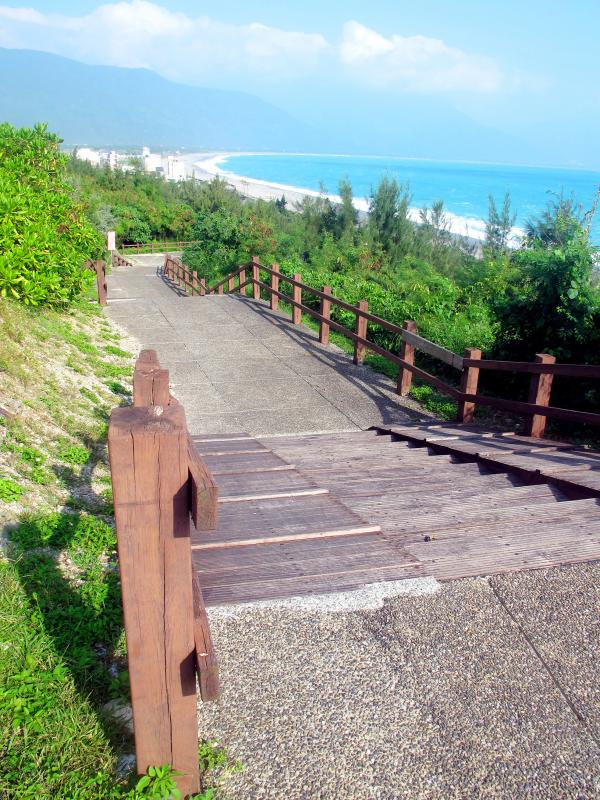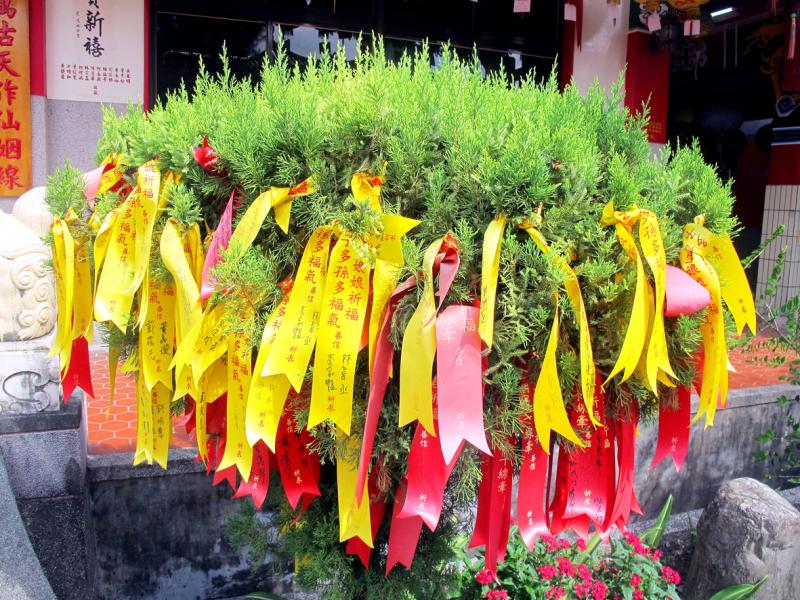For tourists visiting Hualien, Taroko National Park (太魯閣國家公園) is the first order of business. But if you find yourself in the city with half a day to spare — your train back to Taipei will leave mid-afternoon, say — it’s hardly worth busing out to Taroko Gorge. Instead, borrow or rent a bicycle or a scooter, or hail a cab, and set out for one of these attractions. At only one of these places is there an admission charge.
CISINGTAN SCENIC AREA
A literal translation of Cisingtan (七星潭) would be “Seven Stars Pond,” but there’s no pond here, just the vast Pacific Ocean. Back in the 19th century, this toponym was applied to a different place, one with a small lake several hundred meters inland of the current Cisingtan.

Photo: Steven Crook
In 1936, when the Japanese then ruling Taiwan established the military airfield which evolved into today’s Hualien Airport, the residents of old Cisingtan were forced to move, and the pond was filled in. The displaced families settled next to the sea. They carried the place name, as well as their belongings, to the new neighborhood.
The beach here isn’t safe for swimming, but in good weather, Cisingtan Scenic Area (七星潭海岸風景特定區) offers top-notch views of huge mountains abutting the ocean. If you’d like to explore the area by bicycle, there’s a rental business at 76, Alley 1, Lane 10, Mingtan Street (新城鄉明潭街10巷1弄76號). It’s open 7am to 6pm every day.
SHENGAN TEMPLE

Photo: Steven Crook
Few temples can date their founding as precisely as this richly decorated hall of worship.
Shengan Temple (勝安宮) traces its history to six o’clock on the morning of the 13th day of the sixth lunar month in 1949. At that moment, following an all-night seance led by a widow who hoped to learn how her recently-deceased husband was faring in the afterworld, the Queen Mother of the West (西王母, a deity worshipped in China long before the emergence of Taoism) spoke through the mouth of a young man surnamed Su (蘇).
It’s not clear if Su, who’d recently arrived in Hualien after being demobilized from the Chinese Nationalist Party (KMT) army, played any further role in the cult. Whether he did or not, the sect that emerged in this suburb has gone from strength to strength, despite at least one schism.

Photo: Steven Crook
It has even established a branch in Haiti, where local disciples call the Queen Mother of the West “Golden Mom.” It’s tempting to compare Haitian Vodou, known also as Voodoo, with Taiwanese popular religion, and speculate why the sect could gain a foothold so far from home. Both faiths have massive pantheons, and in both the dead are venerated. What’s more, the faithful aim their prayers more often at lesser spirits than towards any supreme god.
In outline, the current Shengan Temple follows the conventions of Northern-Palace architecture, but its managers have squeezed in some extra features that dispel any sense of austerity. There are trees draped in ribbons, potted orchids, yellow lanterns and carp-filled ponds.
Shengan Temple is 2.6km southwest of Hualien Railway Station at 118 Cihui 3rd St (慈惠三街) in Jian (吉安) Township. It’s open from 4.30am to 10pm daily.

Photo: Steven Crook
YOSHINO SHRINE
Two-and-a-half kilometers west of Shengan Temple, Yoshino Shrine (吉安慶修院) dates from 1917, when a Shingon Buddhist outpost was established here to meet the religious needs of the area’s Japanese immigrants.
The complex retains much of its original appearance, and within the grounds there are 88 stone Buddhas, to represent the 88-temple, 1,200km pilgrimage route around Japan’s Shikoku Island.

Photo: Steven Crook
The Million Bright Mantras Stone (光明真言百萬遍石碑) has a reputation for curing the sick. They should visit in person, and chant mantras alongside a Buddhist monastic while walking around the stone 108 times. These days, very few people come here to find a cure or to pray, so the atmosphere is like that of a tourist attraction rather than a place of worship.
The shrine’s address is 345-1 Jhongsing Road (中興路) in Jian Township (吉安鄉). It’s open from 8.30am to 5pm Tuesday to Sunday; admission costs NT$30 for adults, NT$15 for children. It’s possible to get here from central Hualien by bus. The #1131 and #1139 services stop nearby at Jian Township Office (吉安鄉公所), while the #303 Tourist Shuttle stops right outside the shrine. The Tourist Shuttle is worth looking into if you also want to visit Liyu Lake (鯉魚潭) and/or Danong Dafu Forest Park (大農大富平地森林園區).
SAKUL WATERFALL
The paths to Sakul Waterfall (撒固兒瀑布) lie just outside Hualien City, at the northern end of Zuocang Street (佐倉街). The trailhead is 70m above sea level, while the fall itself is at an elevation of 170m. Both paths are a well-maintained mix of compacted soil, gravel and stone.
The shorter of the two routes to the waterfall is 570m in length; the other is 780m, and takes you slightly higher up the hillside. The cascade is 18m high, so it’s neither a tiddler nor a giant by the standards of waterfalls in Taiwan. But combined with the trail, it’s certainly worth a detour.
When I visited earlier this summer, the pool was inhabited by small fish which nibbled on our toes as we cooled our feet in the water. Oddly, none of the Chinese-language blog posts about Sakul Waterfall I looked at mentioned these fish.
Perhaps they were recently and deliberately introduced, possibly by Buddhists practicing “mercy release.” This much-criticized custom involves the setting free of captured creatures, to bring good luck to those who do it, and to make amends for sins committed in previous lives.
Whether or not the species’ presence is a result of human interference, at least one person is concerned. I showed a photo of tiny piscines clustering around my ugly white toes to a friend. He gulped loudly, then quipped: “I’m going to stop eating fish.”
Steven Crook has been writing about travel, culture and business in Taiwan since 1996. He is the author of Taiwan: The Bradt Travel Guide and co-author of A Culinary History of Taipei: Beyond Pork and Ponlai.

This month the government ordered a one-year block of Xiaohongshu (小紅書) or Rednote, a Chinese social media platform with more than 3 million users in Taiwan. The government pointed to widespread fraud activity on the platform, along with cybersecurity failures. Officials said that they had reached out to the company and asked it to change. However, they received no response. The pro-China parties, the Chinese Nationalist Party (KMT) and Taiwan People’s Party (TPP), immediately swung into action, denouncing the ban as an attack on free speech. This “free speech” claim was then echoed by the People’s Republic of China (PRC),

Exceptions to the rule are sometimes revealing. For a brief few years, there was an emerging ideological split between the Democratic Progressive Party (DPP) and Chinese Nationalist Party (KMT) that appeared to be pushing the DPP in a direction that would be considered more liberal, and the KMT more conservative. In the previous column, “The KMT-DPP’s bureaucrat-led developmental state” (Dec. 11, page 12), we examined how Taiwan’s democratic system developed, and how both the two main parties largely accepted a similar consensus on how Taiwan should be run domestically and did not split along the left-right lines more familiar in

Specialty sandwiches loaded with the contents of an entire charcuterie board, overflowing with sauces, creams and all manner of creative add-ons, is perhaps one of the biggest global food trends of this year. From London to New York, lines form down the block for mortadella, burrata, pistachio and more stuffed between slices of fresh sourdough, rye or focaccia. To try the trend in Taipei, Munchies Mafia is for sure the spot — could this be the best sandwich in town? Carlos from Spain and Sergio from Mexico opened this spot just seven months ago. The two met working in the

Many people in Taiwan first learned about universal basic income (UBI) — the idea that the government should provide regular, no-strings-attached payments to each citizen — in 2019. While seeking the Democratic nomination for the 2020 US presidential election, Andrew Yang, a politician of Taiwanese descent, said that, if elected, he’d institute a UBI of US$1,000 per month to “get the economic boot off of people’s throats, allowing them to lift their heads up, breathe, and get excited for the future.” His campaign petered out, but the concept of UBI hasn’t gone away. Throughout the industrialized world, there are fears that